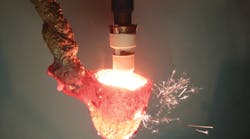For the first time since 2008, SinterCast AB reported a quarterly decline in commercial production volume for its compacted graphite iron process — specifically citing interruptions in shipments of Navistar’s Big Bore commercial vehicle engines. Compared to March 2012, when SinterCast’s Q1 series production totaled 1.60 million engine equivalents, interruptions at two foundries supplying Navistar engine blocks and heads— Tupy in Brazil and the Navistar PurePower foundry in Indianapolis — reduced the number of CGI engine equivalents produced during June by approximately 325,000. That put the annual rate for engine equivalents produced during June at 1.3 million.
Even so, Stockholm-based SinterCast reported a positive outlook for production of engine equivalents and new series production: engine equivalents during May stood at an annualized rate of 1.5 million engine equivalents. (The company uses “engine equivalents” as a measure for each 50 Kg of compacted graphite iron produced under its license.)
After the June drop, the July series production rose to 1.5 million engine equivalents, though Navistar production remained more than 275,000 engine equivalents below its March 2012 level.
CGI is a lightweight alternative to gray iron and aluminum for automotive component manufacturing. SinterCast developed the most widely used process for commercial CGI production. It’s now under license to numerous foundries worldwide and used to cast over 46 different components in series production. A scaled version of the technology has been adopted by several research centers around the world, too.
The Navistar disruptions resulted from a ruling that the engine builder may not rely on earned emissions credits and payment of non-compliance penalties to address the U.S. EPA’s determination that Navistar Class 6 through Class 8 engines fail to meet federal 2010 carbon-emission standards for commercial truck engines (0.20 grams of nitrogen oxide per brake-horsepower hour.) Navistar subsequently implemented a new “clean diesel” technology,” relinquishing its “exhaust gas recirculation” process in favor of the more successful “selective catalytic reduction” (SCR) process. The new engines are expected to debut in early 2013.
SinterCast reported that its series production has not seen any negative effects from the global economic slowdown or the Eurozone crisis. Though commercial vehicle sales in Europe are down, SinterCast said its year-to-year European commercial vehicle sales have increased by approximately 50,000 engine equivalents due to increased production from SinterCast foundries for programs that are dual sourced.
It indicated that V-diesel engine placements for passenger vehicles continue to be strong in Europe, and that series production for U.S. passenger car engine applications are rising, too. The latter includes increases in CGI series production of the Ford 6.7-liter V8 (SinterCast's largest program) and the Jeep Grand Cherokee, a commercial debut set for January.
SinterCast noted production volumes have increased in Asia, too, noting that Hyundai is producing CGI versions of three new commercial vehicle cylinder heads.
SinterCast estimates that the combined potential of its current series production programs and the programs under development represent a market opportunity of approximately 4.6 million engine equivalents per year.
Two further technology developments emerged from SinterCast: it reported that “successful recruitment” of new commercial licenses over the past year has increased “the intensity of the development of new functionality” in its core CGI technology, as well as for its development of a thermal-analysis process control technology for ductile iron.
Improvements in SinterCast’s core CGI technology have already resulted in implementation of a fully automated base-treatment control and a process database for one of its foundry licensees, and base-treatment automation upgrades are under discussion for other customers. New installations of the turnkey System 3000 Plus, introduced recently, are under discussion with existing and new customers that require high volume production solutions.
SinterCast’s ductile iron production technology continues to develop, both in-house and at external trials, to define the technical correlations and potential benefits. It said its proposed thermal analysis control technology would provide a net cost-benefit in ductile iron production by reducing magnesium consumption, improving mold yield, reducing casting defects, and improving machinability of the finished castings.
The company said discussions with customers have been initiated in anticipation of a commercial introduction of the ductile-iron production technology.









